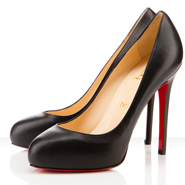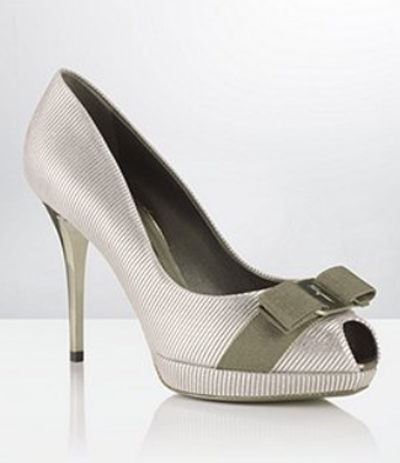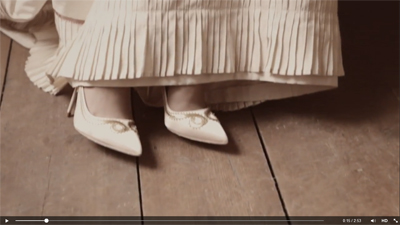 Louboutin shoes
Louboutin shoes
Forty-five percent of women buy at least five pairs of shoes per year, a trend that suggests massive impending growth in the market, according to a new report by Fashionbi.
In the next 10 years, 1 billion women will join the work force, meaning that the women’s footwear market's growth will accelerate as long as it retains its desirability. The impending growth marks a significant opportunity and should lead brands to consider the role of women’s footwear in their businesses.
“These are the booming markets with only positive sales forecasts in terms of fashion and luxury goods purchases,” said Ambika Zutshi, CEO of Fashionbi, Milan, Italy. “Hence, it goes without saying how fruitful could it be in the long run, especially for the premium brands, to establish a strong mark here.
“Plus, at present, the competition is not as intense compared to the countries' Western counterparts, so the opportunity is golden at present,” she said. “The sooner a brand will understand the culture and define a target to market on, the better it is for the brand to already test the market and establish long-term goals of success.”
“Premium Shoes Market: Which Are the Top Luxury Footwear Brands For Women and Why?” looks at the growth of the footwear market and ranks 15 brands according to annual revenues for the 2013 and 2014 fiscal years, the number of stores the brand has open, the size of its social media audience and its rank on Fashionbi’s index score.
Crowded at the top
Because footwear is a seasonal accessory, new styles and trends will lead to faster sales than would be the case for other products. Footwear sales at retailer Neiman Marcus grew by more than one-third in April 2014, and the product has a replenishment rate of 72 percent at Bergdorf Goodman.
 Salvatore Ferragamo
The rapid growth of the industry represents an opportunity for leading footwear brands to retain success and for emerging players to make a push for greater recognition.
At first glance, Salvatore Ferragamo is best positioned. It ranked highest thanks to the greatest revenue and largest distribution network and third place finishes in social media audience size and Fashionbi Index score.
Louboutin, which led the pack in social media audience and Fashionbi Index score, was second overall. Despite also being second in revenue, an 8th place rank in the size of its distribution network bogged it down.
Tod’s, Jimmy Choo, Stuart Weitzman and Hogan finished third through sixth, while Manolo Blahnik was seventh overall. Manolo Blahnik was only 13th in annual revenue, but its large distribution network and social audience elevated it above a number of other brands.
However, a closer look reveals that some lower-ranked brands may be better positioned. Ferragamo leads in revenue, but only 42.7 percent of the brand’s revenue is attributable to footwear, compared to 70 percent for Tod’s.
Salvatore Ferragamo
The rapid growth of the industry represents an opportunity for leading footwear brands to retain success and for emerging players to make a push for greater recognition.
At first glance, Salvatore Ferragamo is best positioned. It ranked highest thanks to the greatest revenue and largest distribution network and third place finishes in social media audience size and Fashionbi Index score.
Louboutin, which led the pack in social media audience and Fashionbi Index score, was second overall. Despite also being second in revenue, an 8th place rank in the size of its distribution network bogged it down.
Tod’s, Jimmy Choo, Stuart Weitzman and Hogan finished third through sixth, while Manolo Blahnik was seventh overall. Manolo Blahnik was only 13th in annual revenue, but its large distribution network and social audience elevated it above a number of other brands.
However, a closer look reveals that some lower-ranked brands may be better positioned. Ferragamo leads in revenue, but only 42.7 percent of the brand’s revenue is attributable to footwear, compared to 70 percent for Tod’s.
 Still from Manolo Blahnik "Walk With Me" video
Charlotte Olympia, ranked 13th overall and 12th in revenue, grew sales by almost 60 percent from 2013 to 2014, faster than any of its competitors.
Also, a handful of ranked brands – Stuart Weitzman, Manolo Blahnik, L.K. Bennett, Charlotte Olympia and Brian Atwood – do not have a men’s line. Likewise, none have expanded their offerings as widely as Ferragamo, which offers jewelry and watches, fragrances, eyewear, apparel, small accessories, bags and small leather goods.
Also of note, Louboutin dominates in social media following, which suggests a loyal fanbase and attraction to aspirationals, but it is also among the most active on the channels. While frequent updates will naturally lead to larger followings, some brands are still wary about social media, fearing that it may risk jeopardizing their prestige and exclusivity by placing themselves on the level of consumers.
Still from Manolo Blahnik "Walk With Me" video
Charlotte Olympia, ranked 13th overall and 12th in revenue, grew sales by almost 60 percent from 2013 to 2014, faster than any of its competitors.
Also, a handful of ranked brands – Stuart Weitzman, Manolo Blahnik, L.K. Bennett, Charlotte Olympia and Brian Atwood – do not have a men’s line. Likewise, none have expanded their offerings as widely as Ferragamo, which offers jewelry and watches, fragrances, eyewear, apparel, small accessories, bags and small leather goods.
Also of note, Louboutin dominates in social media following, which suggests a loyal fanbase and attraction to aspirationals, but it is also among the most active on the channels. While frequent updates will naturally lead to larger followings, some brands are still wary about social media, fearing that it may risk jeopardizing their prestige and exclusivity by placing themselves on the level of consumers.
“It is not at all about spamming the audience by being aggressively active, but it is, in fact, the quality of posts and how engaging the content is that makes a brand a hero—or a zero,” Ms. Zutshi said. “It is how seamlessly a brand provides the experience to its social media audience, and how easily a follower can find the path to purchase on a brand's website through its social media communication. “It is not by chance that the social media platforms invented the ‘buy’ buttons for the brands to cut the middle steps in the purchase process for a brand's potential customers,” she said. To reach the 1 billion emerging consumers before competitors, brands must be properly located. Ferragamo currently has two stores in Africa, while Manolo Blahnik has one, giving these brands an advantage in connecting with the large, growing middle classes of Lagos, Nigeria and Johannesburg and Cape Town. Even before consumers can purchase the brands’ products, being visible will create desirability and make purchases more likely when consumers can eventually afford the footwear. Likewise, Ferragamo leads in Asia and the Middle East, two other fast-growing and populous areas, with 219 stores, more than triple Tod’s and quadruple Jimmy Choo, Louboutin and Manola Blahnik. Ferragamo also has 17 stores in Oceania, while the 14 other ranked brands combined have just 24.
 Kate Hudson for Jimmy Choo
As globalization leads to increased tourism and to prospering classes in regions seen as unlikely not long ago, a large part of staying desirable will be ensuring a global presence.
Also included in the report is a breakdown of the celebrity ambassadors and collaborations of each brand. Celebrities have the ability to transcend borders and appeal to a wide range of people, so well chosen ambassadors could help boost a brand’s image in certain locations.
Talk of the town
Previous Fashionbi research has found that social media has an enormous impact on generating sales.
Social media has become an integral aspect of fashion marketing, with the 56 percent of consumers following branded accounts likely to spend more on purchases than those who do not, according to a Fashionbi report from earlier this December.
A social media presence is just one aspect of an omnichannel strategy, a consumer journey that bridges online and offline interactions ripe with content, experience and high-end service to spur purchase decisions. Omnichannel has become a signifier for “exceptional” brands, but Fashionbi’s “Mystery Shopping: Are the brands really able to omni-market, as they claim?” report looks to determine the actuality of the practice (see story).
Similarly, celebrity faces are by now an expected part of marketing for most luxury brands.
Fashion brands have increasingly been picking famous faces over professional models for their advertising campaigns, favoring the well known over the generally unfamiliar.
Most recently, Marc Jacobs unveiled singer Cher as the face of its fall/winter 2015 campaign and Dior selected pop star Rihanna for its Secret Garden effort. While these celebrities may bring more attention to the ads due to their notoriety, what impact do these choices actually have on the brands (see story)?
“Celebrities, especially when trendy and 'hot in the moment' add a lot of credibility and reputation to the associated brand,” Ms. Zutshi said. “If anyone from the royal family is witnessed wearing certain brand's products, these posts immediately make the brand hit a homerun on the social media and its product are sold-out in no time, as well.
“For instance, this summer, Prince George was spotted wearing Crocs at a polo game and the pair sold out within moments from the publishing of this news,” she said. “Carrie Bradshaw from Sex and The City series made Manolo Blahniks, Jimmy Choos and Christian Louboutins more common household names than ever. The power of a celeb is still immense.
“As far as a brand's followers on their social media go, they are the brand's first potential customers with a high probability to become the brand's loyal customers and furthermore, its advocates. Social media is a platform to lure them, engage them, listen to them and provide services, both pre, during and after-sales. This is the way a brand can use its audience most optimally.”
Final Take
Forrest Cardamenis, editorial assistant on Luxury Daily, New York
Kate Hudson for Jimmy Choo
As globalization leads to increased tourism and to prospering classes in regions seen as unlikely not long ago, a large part of staying desirable will be ensuring a global presence.
Also included in the report is a breakdown of the celebrity ambassadors and collaborations of each brand. Celebrities have the ability to transcend borders and appeal to a wide range of people, so well chosen ambassadors could help boost a brand’s image in certain locations.
Talk of the town
Previous Fashionbi research has found that social media has an enormous impact on generating sales.
Social media has become an integral aspect of fashion marketing, with the 56 percent of consumers following branded accounts likely to spend more on purchases than those who do not, according to a Fashionbi report from earlier this December.
A social media presence is just one aspect of an omnichannel strategy, a consumer journey that bridges online and offline interactions ripe with content, experience and high-end service to spur purchase decisions. Omnichannel has become a signifier for “exceptional” brands, but Fashionbi’s “Mystery Shopping: Are the brands really able to omni-market, as they claim?” report looks to determine the actuality of the practice (see story).
Similarly, celebrity faces are by now an expected part of marketing for most luxury brands.
Fashion brands have increasingly been picking famous faces over professional models for their advertising campaigns, favoring the well known over the generally unfamiliar.
Most recently, Marc Jacobs unveiled singer Cher as the face of its fall/winter 2015 campaign and Dior selected pop star Rihanna for its Secret Garden effort. While these celebrities may bring more attention to the ads due to their notoriety, what impact do these choices actually have on the brands (see story)?
“Celebrities, especially when trendy and 'hot in the moment' add a lot of credibility and reputation to the associated brand,” Ms. Zutshi said. “If anyone from the royal family is witnessed wearing certain brand's products, these posts immediately make the brand hit a homerun on the social media and its product are sold-out in no time, as well.
“For instance, this summer, Prince George was spotted wearing Crocs at a polo game and the pair sold out within moments from the publishing of this news,” she said. “Carrie Bradshaw from Sex and The City series made Manolo Blahniks, Jimmy Choos and Christian Louboutins more common household names than ever. The power of a celeb is still immense.
“As far as a brand's followers on their social media go, they are the brand's first potential customers with a high probability to become the brand's loyal customers and furthermore, its advocates. Social media is a platform to lure them, engage them, listen to them and provide services, both pre, during and after-sales. This is the way a brand can use its audience most optimally.”
Final Take
Forrest Cardamenis, editorial assistant on Luxury Daily, New York
